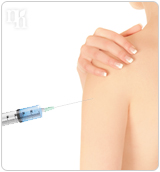Fluctuations in the female sex hormones during menopause cause symptoms such as hot flashes, night sweats, loss of libido, and irregular periods. There are many treatments available to balance the fluctuations in hormone levels and to alleviate the symptoms of menopause. These range from lifestyle changes to alternative treatments and hormone replacement therapy.

Hormone replacement therapy or HRT, is a treatment for menopause symptoms that involves introducing external hormones into the body. As it is, the female sex hormones - estrogen, progesterone, and testosterone - that are the causes behind the symptoms of menopause are all available as HRT. Read on to understand more about estrogen, progesterone, and testosterone replacement therapy.
Estrogen Replacement Therapy
Estrogen replacement therapy (ERT) is concerned with introducing estrogen into the body to counter-balance low levels of estrogen during menopause. Estrogen is the hormone which is responsible for regulating the menstrual cycle. During menopause, as the body prepares for the cessation of menstruation, estrogen enters a stage of flux. These fluctuations manifest themselves in menopausal symptoms. ERT can therefore counter-balance the effects of fluctuating estrogen levels.
Progesterone Replacement Therapy
In progesterone replacement therapy (PRT), progesterone is introduced into the body. Progesterone works with estrogen in controlling the menstrual cycle, and is particularly important during ovulation and pregnancy. Progesterone also plays a key role in instigating the bodily changes that occur during menopause. Supplementing progesterone levels by PRT can be an effective way of relieving menopause symptoms caused by progesterone imbalance.
Testosterone Replacement Therapy

The least utilized strand of HRT is testosterone replacement therapy (TRT), in which levels of testosterone in the body are supplemented. Testosterone is usually associated with male sexual health, but it is present in small quantities in women. It is responsible for strength and sexual desire. Because only a low level of testosterone is present in women, testosterone deficiency is not usually a problem. However, in some cases, TRT is an appropriate treatment for menopause symptoms.
Often, the hormones introduced into the body are a blended according to the woman's hormonal requirements. A blood or saliva test is taken to discern the individual's exact hormonal needs. While HRT can be an effective way to treat hormonal imbalance during menopause, and one which is tailored for your specific hormone levels, there are certain risks associated with it.
